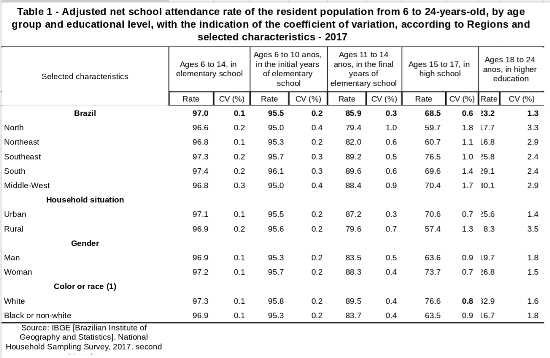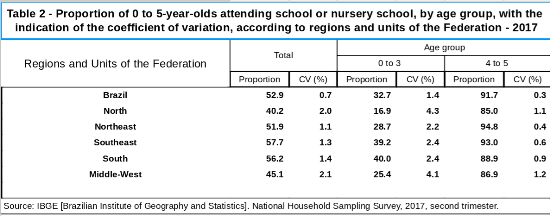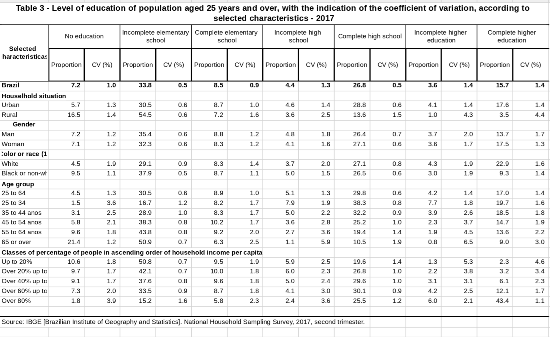Education – SDG 4 and the Brazilian Plan for Education, a necessary connection
Cleo Manhas
Inesc
In 2015, Heads of States and Governments, including Brazil, gathered at the United Nations Headquarters, decided to approve the 2030 Agenda, with 17 sustainable development goals (SDGs) to be achieved through 169 targets1. Among them, there is Goal number 4, which calls on the countries to “Ensure inclusive and equitable quality education and promote lifelong learning opportunities for all”. With 10 targets, 7 of them having a final nature and 3 devoted to means of implementation2.
Since the 1988 Brazilian Constitution, several changes have taken place in national education, especially with the 1996 approval of the non-constitutional legislation, the Education Guidelines and Framework Law. Since then, the mandatory stage of education covers elementary and secondary education, called basic education. Significant progress was made in the first stage of education, which almost universalized vacancies, but in relation to secondary education, the country is still a long way from achieving the targets required to meet the SDGs.
In 2014, one year before the launch of the 2030 Agenda, Brazil approved the 10-year National Education Plan (PNE), up to 2024. Several of its targets are edgier and others are aligned and coincide with the targets of SDG 4. Moreover, if they were met, we would reach the proposed scenario before 2030. It must be said that despite the good intentions regarding the 2030 Agenda, it can be considered a downgrade in terms of human rights. In education, for instance, the proposed target on the agenda is quite generic for the first stage of preschool, which is a serious problem, especially for women who find themselves alone in raising their children and have to pay to get vacancies in nursery schools, since they are not provided by the public power.
With regard to the PNE, it must be pointed out that it was approved with a more advanced text than the one presented by the Executive Branch to the Legislative, thanks to the intense popular participation in its process. It was the bill containing the record for most budgetary amendments proposed by Congressman and woman so far, a product of social movements involvement, represented especially by the Brazilian Campaign for the Right to Education, which includes several movements and organizations working to improve education, including Inesc.
Therefore we will analyze the targets, correlated to the PNE targets: The first target of SDG 4 is the universalization of primary and secondary education for all girls and boys, offering quality education. At PNE, target 3 indicates that by 2016 Brazil should universalize school attendance for the entire population aged between 15 and 17, and by the end of its term, the net enrollment rate in high school would reach 85%. As can be seen in table 1, which shows net school attendance data3, by 2017 only 68% of the population aged between 15 and 17 was attending high school. In addition, if we look at the disaggregated data, we realize that in the North and Northeast the percentage is around 60%, or by race/color, the blacks and non-whites are 63%, that is, below the national average. We can conclude that in addition to Brazil still having a large gross number of adolescents out of school, there are several of them in an age/grade distortion situation, which should have been in high school, but have not yet managed to get out of the elementary school. For a clear picture of the distortion: the gross enrollment rate, in the range of the 15 and 17-years-old, is 87%4, against 68% of net enrollment, which means that about 20% of the people in this age group are in age/grade distortion.
 |
Another important issue to be highlighted in Goal 4.1 is that, besides ensuring that all girls and boys complete basic education, teaching must be of quality and guarantee learning. The Brazilian Education Plan foresaw the implementation of the CAQi and CAQ [acronyms in Portuguese]5, which mean Initial Quality Student Cost and should have been implemented by 2016, and the Quality Student Cost, with regulations foreseen for 2017 and implementation by the end of the PNE 2024 term. Both ensure fair funding to guarantee the necessary inputs to quality education in all basic education, from nursery to high school.
However, these targets did not get off the mark as well. Moreover, especially in the blackest peripheries of the country, we have a serious learning problem. The reasons range from the environment around the children, to the lack of interest of the education system to include them. However, these issues in the current Brazilian context are being seen as only derived from lack of discipline, which is being answered with the militarization of the public schools with higher rates of evasion and age/grade distortion, as well as violence. The current government do not want to go to the root of the difficulties and believe that authoritarian measures will solve the problem, whose causes are the profound inequalities of class, race, gender, territory, to which a large part of the population is exposed.
Target 4.2 relates to early childhood, which includes nursery school and pre-school. In PNE, there are targets for this stage; however, they are moving forward at very slow steps. With regard to pre-school, progress has been made, although universalization has been planned for 2016, there is still a large contingent outside of school, especially if we look at the data by region (see table 2). In the North, for example, 15% of children are still out of pre-school. As for nursery schools, the situation is even more critical, the data for Brazil point to an attendance rate at 32.7%, while in the North region it is only 16.9%. Part of this problem is because these stages are under the responsibility of municipalities, which, with the exception of a few Brazilian cities with good tax collection capacity, are mostly not able to afford the maintenance of nursery schools, with higher costs due to the characteristics of the service provided. The Federal Government should have to contribute with more resources, but with the austerity measures taken since the approval of the Constitutional Amendment 241 to cap public expenditure, which imposes a freeze on investments for 20 years, resources for social policies are shrinking.
 |
With regard to ensuring equal access for men and women to affordable and quality technical, vocational and tertiary education, including university, which is reflected at target 4.3, we advocate for free and public education for all as a right guaranteed since the Constitution of 1988. But Brazil is far from universalizing access to higher education because we still have previous problems to solve, such as total and functional illiteracy, high dropout rates in high school, and lack of maintenance policies for low-income students in universities. This also makes it difficult to meet target 4.4, of the SDG, in respect to substantially increase the number of youth and adults who have relevant skills, including technical and vocational skills, for employment, decent jobs and entrepreneurship. Regarding technical professional education, according to the National Institute for Educational Studies and Research (Inep), only 5.9% of the PNE target was achieved, despite the growth of 31.6% in professional education enrollments. The pace of growth was 47,000 new enrollments per year; nine times lower than the necessary to reach the number foreseen by 2024.
As can be seen in table 3, in rural areas, only 3.5% of the population over 25 years old has completed higher education. Even though the urban population is much larger than the rural population, the percentage is only 17%. However, with regard to gender, there are more women holding a higher education diploma than men, 17% and 13% respectively. This does not reflect employability, since men occupy higher-paid and higher-ranked positions, although women have more years of schooling. Comparing whites and blacks, we can notice that the distance is enormous, corroborating racial inequality, the numbers are 22% and 9% respectively, a distance of 13 percentage points.
 |
Gender disparity, mentioned in target 4.5, does not exist in Brazilian education, at any level of education, since women present a better performance than men do. In addition, with regard to people with disabilities, there are also good news, since the PNE target is close to being met. Today, about 90% of children with global developmental delays or high capacities are in school, with access to the necessary supplies, according to Inep data. There are other problems to be solved, such as a large number of LGBTI+ students dropping out for discrimination and bullying. With regard to indigenous peoples, we have schools prepared to serve and work with the different cultures and languages, but they are not present in all territories and the number of indigenous people reaching the top level is minimal, still being subject of newspaper stories those who successfully graduate or postgraduate.
Regarding youth and adult literacy and numeracy, SDG target 4.6, which corresponds to PNE target 5, according to Inep’s analysis, the results are still far from satisfactory. About 2/3 of the students in the 3rd year of elementary school can only read the words and not an entire text, according to the National Literacy Assessment (acronym in Portuguese, ANA). Territorial inequalities are also explicit, since the worst results are found in the North and Northeast regions. With respect to writing proficiency, the results are better; approximately 57% of students are in level four, of five levels. In math, most students are on level two of the scale. For the North and Northeast regions, the percentage of students in level one, of four levels, exceeds 35% and, in some of the aforementioned regions’ states, the percentage exceeds 40%. With regard to those over 25-year-old, as we can see in table 3, among the rural population and blacks, we still have about 16% of people who declare themselves uneducated.
With regard to target 4.7, it is necessary to mention the current political context in the country, which has caused several setbacks in public policies, especially in education, the target of a retrograde cultural attack, with retrograde proposals such as the School Without Political Parties, the militarization of schools, and the abandonment of universities and programs to encourage the continuity of education.
Human rights are being questioned, as well as the promotion of what is being called gender ideology and cultural Marxism, leading to multiple episodes of teachers being constrained in classrooms, preached against speaking about gender, since it would be anti- religious and anti-family values. This has been strengthened since the PNE vote, when conservative groups managed to remove "promotion of gender equality" from the text. In addition to that, there are efforts en vogue to eliminate from the curricula all forms of diversity, even regarding the history of Africa. There is a strong ethnocentric and colonialist attack. There is also a mixture of government and State because instead of proposing educational policies, they are attacking the democratic management foreseen in the Education Guidelines and Framework Law, dictating the desirable behavior for students top down. And claiming that the root of all problems is disciplinary, and the solution is the "heavy-handed" approach through the militarization of schools.
We are living in a time of struggle. Since social policies in general and education in particular, especially higher education, are not part of the Fund for the Maintenance and Development of Basic Education and Appreciation of Education Professionals (acronym in Portuguese, Fundeb), they are at risk due to the Constitutional Amendment 241 that freezes public spending for 20 years, removing the possibility of expansion and improvement of politics.
Ultraconservative ideas and actions are also threatening, as they attack rights already guaranteed, such as the recognition of the need for policies to encourage access to universities by the black population, the fight against institutional racism and LGBT phobia. Therefore, our moment is one of resistance for the maintenance of rights and a fight against the risks brought by the government not guaranteeing the Brazilian Plan of Education execution and, consequently, not reaching the targets envisioned at the SDG 4.
Notes:
1 Cleo Manhas, political advisor for Inesc, Doctor of Education from PUC/SP.
2 The final targets relate to the immediate achievement of the goals, while those of implementation refer to the necessary resources in order to achieve the ends, such as human, management, technological resources etc.
3 Which is the ratio between the number of student enrollments with the age (15-17) to be in certain stage of education and the population total in the same age group.
4 According to IBGE (Brazilian Institute of Geography and Statistics), National Household Sampling Survey, 2017, second trimester.
5 CAQi is the minimum standard established by the PNE as a demand to be fulfilled by June 2016. And CAQ for instance goes beyond the minimum standard by considering also the dynamic cost by student and takes into account Brazil’s economic capacity. Therefore, CAQ is the quality control that brings Brazil closer to developed countries standards in terms of education. It should have been established up to 3 years after the approval of the PNE, in 2017, and implemented until 2024.
While CAQi has the Brazilian Minimum Wage for Teaching Law as reference for compensation of public education professionals and the school day a partial period of 5 hours, with exception made to nursery schools with 10-hour period, the Brazilian Campaign For the Right to Education understands that CAQ should consider as school day at least 7-10 hours for the students and that the minimum wage for education professionals should be based on the calculus of what a minimum wage should be as established by research institute DIEESE (Departamento Intersindical de Estatística e Estudos Socioeconômicos). Source: www.custoalunoqualidade.org.br.

